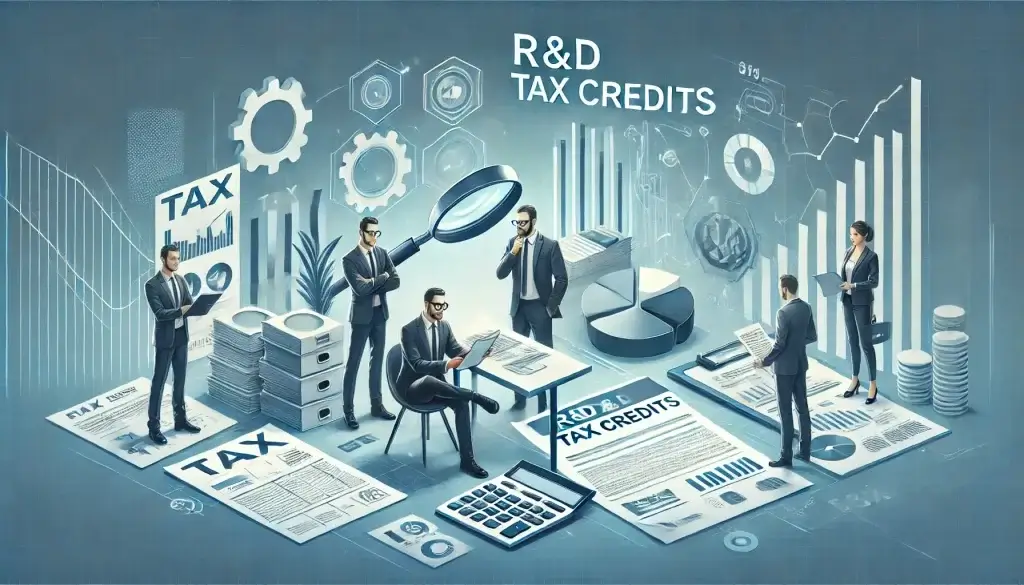The Research and Development (R&D) Tax Credit offers businesses a significant opportunity to reduce their tax liabilities while fostering innovation. However, navigating the complexities of eligibility, documentation, and compliance can be challenging. This guide explores how businesses can leverage expert assistance and modern tools to maximize their tax benefits while staying compliant with IRS requirements.
Why Engage Tax Professionals and Experts in R&D Credits?
For many businesses, the R&D Tax Credit represents a valuable but underutilized opportunity. The process of claiming this credit involves understanding intricate IRS requirements, maintaining thorough documentation, and demonstrating the eligibility of activities and expenses. Tax professionals and experts specializing in R&D credits play a pivotal role in simplifying this process.
Key Benefits of Professional Assistance
- Maximizing Tax Benefits: Professionals who specialize in R&D credits are well-versed in identifying eligible activities and expenses that businesses might overlook. They can help ensure that you maximize the credits available to you.
- Compliance and Risk Reduction: Incorrect claims can result in audits, penalties, and additional scrutiny from the IRS. Experts ensure that claims are accurate, substantiated, and compliant with the latest regulations.
- Tailored Guidance: Every business operates differently. A tax professional can provide personalized advice, taking into account your industry, operations, and specific R&D activities.
- Time Savings: Preparing an R&D Tax Credit claim can be time-consuming. Outsourcing this task to an expert allows your team to focus on core business operations.
When to Seek Expert Assistance
- If your business is new to claiming the R&D Tax Credit.
- If you lack internal resources to manage the application process.
- If your R&D activities involve complex or specialized projects.
Engaging a professional early in the process can save you time, money, and potential headaches down the line.
The Role of Modern Tools and Services in R&D Tax Credit Documentation
Proper documentation is the cornerstone of a successful R&D Tax Credit claim. It demonstrates the eligibility of activities, substantiates expenses, and protects your business in the event of an audit. Modern tools and professional services can greatly streamline the documentation and claim preparation process.
Benefits of Using Modern Tools
- Automation: Software solutions can automate data collection and organization, reducing manual errors and saving time.
- Integration: Many tools integrate seamlessly with platforms like payroll, project management, and accounting software, ensuring comprehensive data capture.
- Accuracy: Advanced technologies, such as AI, can analyze data to identify qualifying activities and expenses with greater precision.
- Audit Readiness: These tools often include features that help prepare audit-ready documentation, ensuring your claims are backed by robust evidence.
Examples of Modern Tools and Services
- R&D Credit Software: Tools like TaxPoint or BDO R&D Credit Manager simplify data collection and reporting.
- Time-Tracking Solutions: Platforms such as Harvest or Toggl can help track employee hours spent on qualifying activities.
- Consulting Services: Many firms offer end-to-end solutions, combining human expertise with technology for comprehensive claim preparation.
Tips for Choosing the Right Tool or Service
- Ensure it aligns with your industry-specific needs.
- Look for user-friendly interfaces and robust customer support.
- Consider scalability to accommodate future growth and increased R&D activities.
By leveraging these tools and services, businesses can streamline the documentation process, reducing the burden on internal teams while ensuring compliance with IRS requirements.
Staying Updated: Recent Changes in R&D Tax Credit Regulations
The regulatory landscape surrounding the R&D Tax Credit is constantly evolving. Staying informed about these changes is essential for businesses to remain compliant and optimize their claims.
Key Recent Changes
- Amortization of R&D Expenses: Starting in 2022, businesses are required to amortize domestic R&D expenses over five years and foreign R&D expenses over 15 years. This change significantly impacts how businesses account for and claim these expenses.
- Increased Documentation Requirements: The IRS has heightened scrutiny on R&D claims, emphasizing the need for detailed documentation. Businesses must now provide more comprehensive evidence of qualifying activities and expenses.
- Expansion of Eligible Activities: Recent guidance has clarified the inclusion of certain software development activities and other innovative projects within the scope of the R&D Tax Credit.
- State-Level Incentives: Many states have introduced or expanded their own R&D tax credits. Businesses should explore opportunities at both the federal and state levels.
Best Practices for Staying Informed
- Subscribe to Industry Newsletters: Regular updates from tax and legal firms can keep you informed of regulatory changes.
- Attend Webinars and Workshops: These events often provide in-depth insights into recent developments and best practices.
- Engage with Experts: Tax professionals can provide tailored guidance on how new regulations impact your business.
Building a Strong R&D Tax Credit Strategy
To maximize the benefits of the R&D Tax Credit, businesses need a well-thought-out strategy that combines expert assistance, modern tools, and updated knowledge of regulations.
Steps to Develop an Effective Strategy
- Assess Eligibility: Work with professionals to identify qualifying activities and expenses within your operations.
- Streamline Documentation: Invest in tools that automate and organize data collection to ensure thorough and accurate documentation.
- Stay Proactive: Regularly review your R&D activities and expenses to ensure they align with IRS guidelines.
- Monitor Regulatory Changes: Keep abreast of updates to regulations and adjust your strategy accordingly.
- Leverage Professional Expertise: Collaborate with tax professionals who can guide you through the complexities of the application process and help optimize your claims.
Common Mistakes to Avoid
- Underestimating Documentation Requirements: Inadequate records can lead to denied claims and potential audits.
- Overlooking State-Level Credits: Many businesses miss out on additional savings by focusing solely on federal incentives.
- Filing Late: Ensure timely submission to avoid missing out on valuable credits.
Conclusion
The R&D Tax Credit offers tremendous potential for businesses to reduce tax liabilities while fostering innovation and growth. However, the complexities of the application process can be daunting. By engaging tax professionals, leveraging modern tools, and staying informed about regulatory changes, businesses can navigate these challenges effectively.
Whether you’re new to the R&D Tax Credit or looking to optimize your claims, taking a strategic approach will ensure you maximize your benefits and stay compliant with IRS requirements. Remember, the right resources and expert guidance can make all the difference.
Cassia Rowley is the mastermind behind advertising at The Bad Pod. She blends creativity with strategy to make sure ads on our site do more than just show up—they spark interest and make connections. Cassia turns simple ad placements into engaging experiences that mesh seamlessly with our content, truly capturing the attention of our audience.


